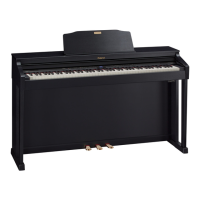Various Settings (Function Mode)
Indication Value Explanation
Tmpr Key
Specifying a Song’s Tonic (Temperament Key)
When playing with tuning other than equal temperament, you need to specify the
temperament key for tuning the song to be performed (that is, the note that corresponds to
C for a major key or to A for a minor key).
If you choose an equal temperament, there’s no need to select a temperament key.
C, C
, D, E , E, F, F ,G, A , A, B , B
* In the display, a quotation mark (“) signies a sharp (#).
Dmpr Res
Producing Sympathetic Resonance When You Press the Damper Pedal
(Damper Resonance)
This adjusts the damper resonance of the acoustic piano sound (the sympathetic vibration
produced in strings other than those actually played when you press the damper pedal).
Higher settings will make the sympathetic vibration louder.
OFF, 1–10
Strg Res
Producing the Resonance of the Strings When the Keys Are Played
(String Resonance)
This adjusts the string resonance of the acoustic piano sound (the sympathetic vibrations of
strings for previously played notes that occur when you play another note).
Higher settings will make the sympathetic vibration louder.
OFF, 1–10
KO Res
Playing Sounds When the Keys Are Released (Key O Resonance)
This adjusts sympathetic vibrations such as an acoustic piano’s key-o sound (the subtle
sound that occurs when you release a note).
Higher settings will make the sympathetic vibration louder.
OFF, 1–10
DynHarmo
Adjusting the Metallic Sound That Occurs When You Play a Note
(Dynamic Harmonic)
This adjusts the metallic resonance that is produced when you play strongly on an acoustic
piano.
Higher settings will produce a louder metallic sound.
OFF, 1–10
Cabinet
Adjusting the Sympathetic Resonance of the Grand Piano Body
(Cabinet Resonance)
Adjusts the body resonance of the grand piano itself.
Higher values will produce a larger body resonance.
OFF, 1–10
How to save your settings?
Save your settings as described in “Memory
Backup” (p. 41).
How to save your settings?
Save your settings as described in “Memory
Backup” (p. 41).
How to save your settings?
Save your settings as described in “Memory
Backup” (p. 41).
How to save your settings?
Save your settings as described in “Memory
Backup” (p. 41).
How to save your settings?
Save your settings as described in “Memory
Backup” (p. 41).
How to save your settings?
Save your settings as described in “Memory
Backup” (p. 41).
49
Operation Guide Panel Descriptions Before You Play Performing Practicing
Convenient Functions
Appendix
Function Mode

